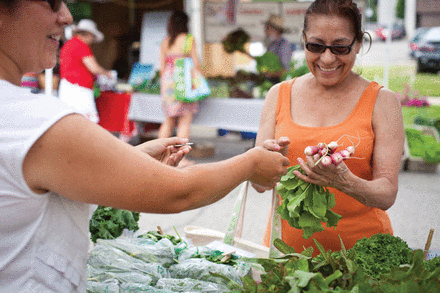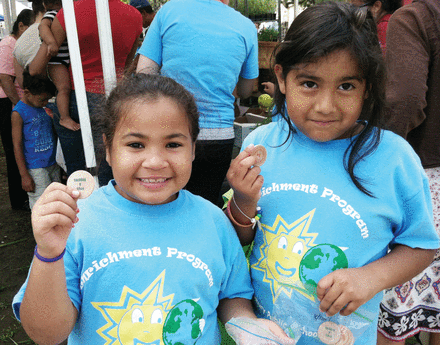Farmers markets bring healthy choices to low-income shoppers: USDA program benefits SNAP users
February 2, 2015
Source: The Nation's Health (APHA)
Author: Natalie McGill
Farmers markets fill many roles in U.S. communities: They serve as a neighborhood hub, put farmers face-to-face with consumers and connect shoppers with fresh locally, grown produce.
Over the past six years, many markets have also played another larger role: providing fruits and vegetables to low-income Americans via the federal Supplemental Nutrition Assistance Program.

A shopper buys vegetables at the Downtown Ypsilanti Famers Market in Ypsilanti, Michigan, last summer. Farmers markets across the U.S. are making it easier for low-income shoppers who are part of the federal SNAP program to use their benefits for fresh fruits and vegetables in their communities. Photo courtesy Chuk Nowak.
And many markets are going the extra mile to give such consumers more bang for their bucks.
Run through the U.S. Department of Agriculture’s Food and Nutrition Services, SNAP is a nutrition assistance program through which low-income families can receive benefits. Those benefits can be used to purchase food at SNAP-authorized retailers, such as grocery stores and farmers markets.
Farmers market participation in SNAP is not completely new, said Kevin Concannon, MSW, under secretary for USDA’s Food, Nutrition and Consumer Services. Farmers markets have been able to participate for more than a decade, but USDA has zeroed in on outreach to farmers markets and partnership organizations in recent years as a vehicle for healthy eating. By the end of fiscal year 2014, there were more than 5,170 U.S. farmers markets and direct-marketing farmers authorized to process SNAP benefits, compared with about 850 in fiscal year 2008, Concannon said.
“We are very interested in doing what we can to promote greater access to healthier foods,” Concannon told The Nation’s Health. “Farmers market food is typically less processed food, locally grown most of the time and fresh, and the markets provide a way of connecting our SNAP consumers to those fruits and vegetables — items all Americans can use more of.”
Nutritionist Peggy Zamore, RD, knows how little produce Americans consume. Zamore, of Danbury, Connecticut, runs the Danbury Farmers Market Better Health Through Better Food Project, which not only accepts SNAP benefits but also matches the first $9 spent in SNAP benefits at the market.
The weekly market preceded the project, which began in 2010 to bring equitable access to fresh local food to low-income areas of Danbury, she said.
“I saw this as a way to not just tell people how to eat, but give them the resources to eat the right food, to follow good nutrition advice and provide them with the resources to do that,” Zamore told The Nation’s Health.

Children in Danbury, Connecticut, show SNAP tokens used to buy fresh produce at the Danbury Farmers Market. The farmers market is one of thousands in the U.S. that accepts SNAP benefits to encourage the purchase of more fresh produce. Photo courtesy Peggy Zamore.
Zamore said the feedback on using the SNAP benefits, along with the incentive to get even more produce, has been positive. From 2013 to 2014, there was a 60 percent increase in the number of SNAP participants who received the $9 incentive — from 246 to 398 participants. Prior to that, there was a significant increase from 2012 to 2013 — from 110 to 246 participants.
“One thing I learned very quickly by doing this is people who are typically thought of as wanting to want junk food don’t want to eat junk food,” Zamore said. “They want to eat fresh produce and they’re thrilled when they can afford to buy it.”
Honoring SNAP benefits and spreading the word is not without its challenges. Working the equipment needed to process SNAP benefits is one of them. As there are typically no electrical outlets at a farmers market, a wireless machine is needed to process the electronic benefit transfer cards SNAP customers use to redeem their benefits.
“When the USDA went to an EBT system for SNAP, that created a big problem…for redemption of benefits at farmers markets because before that they had paper,” Zamore said. “Now you have to have a machine to be able to accept these benefits and the machines are very costly. They cost about $600 or $700.”
One answer to such barriers comes through USDA’s MarketLink program, which debuted in January 2014. The program provides an Internet portal that assists farmers with issues related to equipment and setup to accept SNAP payments. Since its debut, more than 750 markets and farmers received EBT equipment and more than 600 markets and farmers received assistance to become SNAP-authorized, he said.
In Danbury, the money for the $9 incentive is also raised through grant funding, Zamore said. However, thanks to a recent USDA program, many market managers across the U.S. are hoping for a federal government boost to provide those incentives.
The Agricultural Act of 2014, passed in February 2014, includes $100 million for the Food Insecurity Nutrition Incentive Program. The program will award grants to farmers markets that have or create programs that incentivize the purchase of more produce through SNAP.
Members of Michigan’s Fair Food Network see that $100 million as a confirmation of the existing work organizations like theirs have done to provide incentives for SNAP recipients to purchase produce.
In 2009, the network began its Double Up Food Bucks Program at five farmers markets in Detroit. Families that spend $20 in SNAP benefits at a farmers market can receive $20 in Double Up Food Bucks to spend on Michigan-grown fruits and vegetables.
Today, the program has expanded to more than 150 sites across Michigan and northern Ohio, with more than 3 million pounds of produce bought with SNAP benefits and food bucks since 2009. In 2013, there were more than 10,000 first-time SNAP customers in Michigan farmers markets, according to a five-year program report.
Partnerships are a driving force in the Fair Food Network’s success of Double Up Food Bucks, with partners holding cooking demonstrations in markets that accept accept food bucks and distributing nutrition information to SNAP recipients, said Fair Food Network CEO Oran Hesterman, PhD.
A partnership with the United Way and the Detroit Lions NFL team allowed low-income Detroit Public School kids the chance to shop for local produce at Detroit’s Eastern Market using food bucks tokens alongside Lions players.
“They take it back to parents, and a huge proportion of families in Detroit Public Schools are SNAP-eligible or are on SNAP,” Hesterman said. “It’s all about the partnerships. One organization doesn’t need to do it all. Working together across organizations, we can spread the message and change behaviors.”
Overall, he said incentive programs like Double Up Food Bucks are a win for families because they bring home healthier foods and are good for communities because local food dollars go back into the local economy.
And a provision such as the Food Insecurity Nutrition Incentive Program is a “huge win” that could expand similar benefits across farmers markets and other retail settings nationwide, he said.
“It’s going to take a lot of work to keep it in the farm bill the next time it’s up for reauthorization,” Hesterman said. “Support from the public health community emphasizing the health benefits of incentives will be crucial in affirming this policy in future legislation.”
For more information, visit www.fns.usda.gov/ebt/learn-about-snap-benefits-farmers-markets.
Copyright The Nation’s Health, American Public Health Association. First posted at The Nation's Health.







